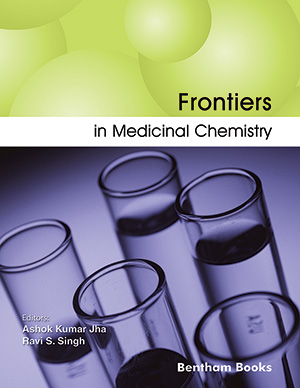Abstract
Background: Thiazolidine-2,4-dione (2,4-TZD) is a flexible pharmacophore and a privileged platform and contains a five-membered ring with a 2-oxygen atom with double bond 2,4- position and one nitrogen atom as well as sulphur containing in the heterocyclic compound. A famous electron-rich nitrogen transporter combines invigorating electronic properties with the prospective for elemental applications. Thiazolidine-2,4-dione analogues have been synthesized using a variety of methods, all of which have shown to have a strong biological effect.
Objectives: The study of the biological activity of Thiazolidine-2,4-dione derivatives has been a fascinating field of pharmaceutical chemistry and has many purposes. This derivative described in the literature between 1995 to 2023 was the focus of this study. Thiazolidine-2,4-diones have been discussed in terms of their introduction, general method, synthetic scheme and antidiabetic significance in the current review.
Conclusion: Thiazolidine-2,4-diones are well-known heterocyclic compounds. The synthesis of Thiazolidine-2,4-diones has been described using a variety of methods. Antidiabetic activity has been discovered in several Thiazolidine-2,4-dione derivatives, which enhance further research. The use of Thiazolidine-2,4-diones to treat antidiabetics has piqued researchers' interest in learning more about thiazolidine-2,4-diones.
Keywords: Diabetic, Thiazolidine-2, 4-dione, Antidiabetic potential, Proteins, Receptors, Synthetic schemes.
Current Topics in Medicinal Chemistry
Title:Synthetic Strategies of Thiazolidine-2,4-dione Derivatives for the Development of New Anti-diabetic Agents: Compressive Review
Volume: 24 Issue: 10
Author(s): Pushkar Kumar Ray*, Km Shabana, Salahuddin and Rajnish Kumar
Affiliation:
- Department of Pharmacy, Harlal Institute of Management and Technology (HIMT), Plot no-8, Knowledge Park-1, Greater Noida, Uttar Pradesh, 201310, India
Keywords: Diabetic, Thiazolidine-2, 4-dione, Antidiabetic potential, Proteins, Receptors, Synthetic schemes.
Abstract:
Background: Thiazolidine-2,4-dione (2,4-TZD) is a flexible pharmacophore and a privileged platform and contains a five-membered ring with a 2-oxygen atom with double bond 2,4- position and one nitrogen atom as well as sulphur containing in the heterocyclic compound. A famous electron-rich nitrogen transporter combines invigorating electronic properties with the prospective for elemental applications. Thiazolidine-2,4-dione analogues have been synthesized using a variety of methods, all of which have shown to have a strong biological effect.
Objectives: The study of the biological activity of Thiazolidine-2,4-dione derivatives has been a fascinating field of pharmaceutical chemistry and has many purposes. This derivative described in the literature between 1995 to 2023 was the focus of this study. Thiazolidine-2,4-diones have been discussed in terms of their introduction, general method, synthetic scheme and antidiabetic significance in the current review.
Conclusion: Thiazolidine-2,4-diones are well-known heterocyclic compounds. The synthesis of Thiazolidine-2,4-diones has been described using a variety of methods. Antidiabetic activity has been discovered in several Thiazolidine-2,4-dione derivatives, which enhance further research. The use of Thiazolidine-2,4-diones to treat antidiabetics has piqued researchers' interest in learning more about thiazolidine-2,4-diones.
Export Options
About this article
Cite this article as:
Ray Pushkar Kumar*, Shabana Km, Salahuddin and Kumar Rajnish, Synthetic Strategies of Thiazolidine-2,4-dione Derivatives for the Development of New Anti-diabetic Agents: Compressive Review, Current Topics in Medicinal Chemistry 2024; 24 (10) . https://dx.doi.org/10.2174/0115680266284283240304071648
| DOI https://dx.doi.org/10.2174/0115680266284283240304071648 |
Print ISSN 1568-0266 |
| Publisher Name Bentham Science Publisher |
Online ISSN 1873-4294 |
Call for Papers in Thematic Issues
AlphaFold in Medicinal Chemistry: Opportunities and Challenges
AlphaFold, a groundbreaking AI tool for protein structure prediction, is revolutionizing drug discovery. Its near-atomic accuracy unlocks new avenues for designing targeted drugs and performing efficient virtual screening. However, AlphaFold's static predictions lack the dynamic nature of proteins, crucial for understanding drug action. This is especially true for multi-domain proteins, ...read more
Artificial intelligence for Natural Products Discovery and Development
Our approach involves using computational methods to predict the potential therapeutic benefits of natural products by considering factors such as drug structure, targets, and interactions. We also employ multitarget analysis to understand the role of drug targets in disease pathways. We advocate for the use of artificial intelligence in predicting ...read more
Chemistry Based on Natural Products for Therapeutic Purposes
The development of new pharmaceuticals for a wide range of medical conditions has long relied on the identification of promising natural products (NPs). There are over sixty percent of cancer, infectious illness, and CNS disease medications that include an NP pharmacophore, according to the Food and Drug Administration. Since NP ...read more
Current Trends in Drug Discovery Based on Artificial Intelligence and Computer-Aided Drug Design
Drug development discovery has faced several challenges over the years. In fact, the evolution of classical approaches to modern methods using computational methods, or Computer-Aided Drug Design (CADD), has shown promising and essential results in any drug discovery campaign. Among these methods, molecular docking is one of the most notable ...read more
 10
10
- Author Guidelines
- Graphical Abstracts
- Fabricating and Stating False Information
- Research Misconduct
- Post Publication Discussions and Corrections
- Publishing Ethics and Rectitude
- Increase Visibility of Your Article
- Archiving Policies
- Peer Review Workflow
- Order Your Article Before Print
- Promote Your Article
- Manuscript Transfer Facility
- Editorial Policies
- Allegations from Whistleblowers
- Announcements




























